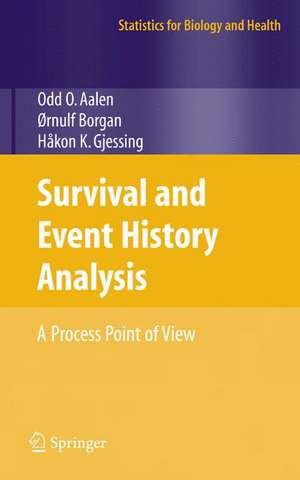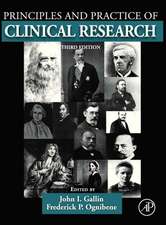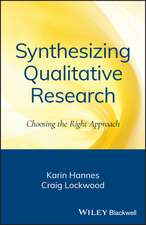Survival and Event History Analysis: A Process Point of View: Statistics for Biology and Health
Autor Odd Aalen, Ornulf Borgan, Hakon Gjessingen Limba Engleză Hardback – 12 aug 2008
The stochastic process framework is naturally connected to causality. The authors show how dynamic path analyses can incorporate many modern causality ideas in a framework that takes the time aspect seriously.
To make the material accessible to the reader, a large number of practical examples, mainly from medicine, are developed in detail. Stochastic processes are introduced in an intuitive and non-technical manner. The book is aimed at investigators who use event history methods and want a better understanding of the statistical concepts. It is suitable as a textbook for graduate courses in statistics and biostatistics.
| Toate formatele și edițiile | Preț | Express |
|---|---|---|
| Paperback (1) | 1120.37 lei 6-8 săpt. | |
| Springer – 23 noi 2010 | 1120.37 lei 6-8 săpt. | |
| Hardback (1) | 1124.60 lei 6-8 săpt. | |
| Springer – 12 aug 2008 | 1124.60 lei 6-8 săpt. |
Din seria Statistics for Biology and Health
- 20%
 Preț: 633.23 lei
Preț: 633.23 lei - 17%
 Preț: 352.01 lei
Preț: 352.01 lei - 20%
 Preț: 776.71 lei
Preț: 776.71 lei - 20%
 Preț: 1376.32 lei
Preț: 1376.32 lei - 18%
 Preț: 1394.84 lei
Preț: 1394.84 lei - 18%
 Preț: 883.59 lei
Preț: 883.59 lei - 5%
 Preț: 843.91 lei
Preț: 843.91 lei -
 Preț: 397.16 lei
Preț: 397.16 lei - 20%
 Preț: 1002.67 lei
Preț: 1002.67 lei - 18%
 Preț: 1395.32 lei
Preț: 1395.32 lei - 5%
 Preț: 1102.10 lei
Preț: 1102.10 lei - 5%
 Preț: 874.83 lei
Preț: 874.83 lei - 15%
 Preț: 657.39 lei
Preț: 657.39 lei - 18%
 Preț: 960.93 lei
Preț: 960.93 lei - 15%
 Preț: 585.90 lei
Preț: 585.90 lei - 5%
 Preț: 852.69 lei
Preț: 852.69 lei - 18%
 Preț: 903.62 lei
Preț: 903.62 lei - 5%
 Preț: 721.40 lei
Preț: 721.40 lei - 15%
 Preț: 653.46 lei
Preț: 653.46 lei - 18%
 Preț: 2114.90 lei
Preț: 2114.90 lei - 18%
 Preț: 1108.99 lei
Preț: 1108.99 lei - 5%
 Preț: 821.39 lei
Preț: 821.39 lei - 5%
 Preț: 849.02 lei
Preț: 849.02 lei - 15%
 Preț: 653.14 lei
Preț: 653.14 lei - 18%
 Preț: 958.56 lei
Preț: 958.56 lei - 5%
 Preț: 722.69 lei
Preț: 722.69 lei - 18%
 Preț: 728.74 lei
Preț: 728.74 lei - 18%
 Preț: 943.22 lei
Preț: 943.22 lei - 5%
 Preț: 1092.43 lei
Preț: 1092.43 lei - 15%
 Preț: 594.21 lei
Preț: 594.21 lei - 5%
 Preț: 377.87 lei
Preț: 377.87 lei - 18%
 Preț: 1220.12 lei
Preț: 1220.12 lei - 15%
 Preț: 632.98 lei
Preț: 632.98 lei - 18%
 Preț: 1394.84 lei
Preț: 1394.84 lei -
 Preț: 389.11 lei
Preț: 389.11 lei - 18%
 Preț: 959.98 lei
Preț: 959.98 lei
Preț: 1124.60 lei
Preț vechi: 1371.47 lei
-18% Nou
215.19€ • 224.67$ • 178.10£
Carte tipărită la comandă
Livrare economică 05-19 aprilie
Specificații
ISBN-10: 0387202870
Pagini: 539
Ilustrații: XVIII, 540 p.
Dimensiuni: 155 x 235 x 30 mm
Greutate: 0.9 kg
Ediția:2008
Editura: Springer
Colecția Springer
Seria Statistics for Biology and Health
Locul publicării:New York, NY, United States
Public țintă
ResearchCuprins
An introduction to survival and event history analysis.- Stochastic processes in event history analysis.- Nonparametric analysis of survival and event history data.- Regression models.- Parametric counting process models.- Unobserved heterogeneity: The odd effects of frailty.- Multivariate frailty models.- Marginal and dynamic models for recurrent events and clustered survival data.- Causality.- First passage time models: Understanding the shape of the hazard rate.- Diffusion and L#x00E9;vy process models for dynamic frailty.
Recenzii
"The book is intended as a text for biostatistics graduate students. It will fill that role excellently. It will expose them to ideas they are unlikely to encounter in depth in a standard curriculum and is precisely the sort of book to inspire theses and other research projects. Prerequisites include exposure to stochastic processes and basic survival analysis, as well as the mathematical statistics that the standard graduate program provides. Each chapter contains relevant probability theory and data analyses and concludes with a set of exercises.... With its comprehensive and up-to-date bibliography, and extensive index, it is also ideal for self-study.… The book has Springer’s high quality with pleasing typesetting and good margins." (Patricia Grambsch, Biometrics, June 2009, 65)
"…typifies the authors’ interest in understanding the mechanisms that underlie developments over times, as does the brilliant chapter on causality. In summary, Aalen, Borgan, and Gjessing have managed to write a book which is both practical and thought-provoking, wide-ranging yet focused, and above all, accessible. It will be around for a long time." (Robin Henderson, Significance, September 2009)
"Readership: Practicing statisticians as well as theoreticians interested in survival analysis. Also suitable for a graduate course. Very well written. … Aalen, Borgan and Gjessing have written a new book which is also likely to have a profound influence on the subject, possibly both from the classical and Bayesian point of view … . The book is based on point processes … . Deep facts about these processes as well as martingales and stochastic integrals are introduced and used throughout with clarity and intuitive insight." (Jayanta K. Ghosh, International Statistical Review, Vol. 77 (3), 2009)
“This book intends to distinguish itself by presenting a broad and comprehensive view of stochastic processes which are useful for the analysis of survival data and, more generally, of ‘event histories’, i.e. series of occurrences of events over time. … In conclusion, this is an excellent book which will be useful to researchers in several fields due to the broad interest of the presented methodologies … .” (Bruno Betrò, Mathematical Reviews, Issue 2010 b)“Inspired by the spread of survival and event history analysis to fields beyond biostatistics and by the increasing complexity of high-quality data structures, the authors have written an elegant text that bridges theory and applications and balances technical detail with pedagogical simplicity. The book moves beyond other textbooks on the topic of survival and event history analysis by using a stochastic processes framework to develop models for events repeated over time or related among individuals. …Overall, the book is masterfully written and a welcome addition to the bookshelf of anyone doing either applied modeling or methodological research in survival or event history analysis.” (Journal of the American Statistical Association, Vol. 105, No. 489)
Textul de pe ultima copertă
Time-to-event data are ubiquitous in fields such as medicine, biology, demography, sociology, economics and reliability theory. Recently, a need to analyze more complex event histories has emerged. Examples are individuals that move among several states, frailty that makes some units fail before others, internal time-dependent covariates, and the estimation of causal effects from observational data.
The aim of this book is to bridge the gap between standard textbook models and a range of models where the dynamic structure of the data manifests itself fully. The common denominator of such models is stochastic processes. The authors show how counting processes, martingales, and stochastic integrals fit very nicely with censored data. Beginning with standard analyses such as Kaplan-Meier plots and Cox regression, the presentation progresses to the additive hazard model and recurrent event data. Stochastic processes are also used as natural models for individual frailty; they allow sensible interpretations of a number of surprising artifacts seen in population data.
The stochastic process framework is naturally connected to causality. The authors show how dynamic path analyses can incorporate many modern causality ideas in a framework that takes the time aspect seriously.
To make the material accessible to the reader, a large number of practical examples, mainly from medicine, are developed in detail. Stochastic processes are introduced in an intuitive and non-technical manner. The book is aimed at investigators who use event history methods and want a better understanding of the statistical concepts. It is suitable as a textbook for graduate courses in statistics and biostatistics.
Odd O. Aalen is professor of medical statistics at the University of Oslo, Norway. His Ph.D. from the University of California, Berkeley in 1975 introduced counting processes and martingales in event history analysis. He has also contributed to numerous other areas of event history analysis, such as additive hazards regression, frailty, and causality through dynamic modeling.
Ørnulf Borgan is professor of statistics at the University of Oslo, Norway. Since his Ph.D. in 1984 he has contributed extensively to event history analysis. He is co-author of the monograph Statistical Models Based on Counting Processes, and is editor of Scandinavian Journal of Statistics.
Håkon K. Gjessing is professor of medical statistics at the Norwegian Institute of Public Health and the University of Bergen, Norway. Since his Ph.D. in probability in 1995, he has worked on a broad range of theoretical and applied problems in biostatistics.
Caracteristici
All topics are covered by thoroughly prepared examples using real data, with ample graphical illustrations
Up-to-date presentation with many new topics, including chapters on causality in time-to-event data and analyses of multivariate survival data
Descriere
Time-to-event data are ubiquitous in fields such as medicine, biology, demography, sociology, economics and reliability theory. Recently, a need to analyze more complex event histories has emerged. Examples are individuals that move among several states, frailty that makes some units fail before others, internal time-dependent covariates, and the estimation of causal effects from observational data.
The aim of this book is to bridge the gap between standard textbook models and a range of models where the dynamic structure of the data manifests itself fully. The common denominator of such models is stochastic processes. The authors show how counting processes, martingales, and stochastic integrals fit very nicely with censored data. Beginning with standard analyses such as Kaplan-Meier plots and Cox regression, the presentation progresses to the additive hazard model and recurrent event data. Stochastic processes are also used as natural models for individual frailty; they allow sensible interpretations of a number of surprising artifacts seen in population data.
The stochastic process framework is naturally connected to causality. The authors show how dynamic path analyses can incorporate many modern causality ideas in a framework that takes the time aspect seriously.
To make the material accessible to the reader, a large number of practical examples, mainly from medicine, are developed in detail. Stochastic processes are introduced in an intuitive and non-technical manner. The book is aimed at investigators who use event history methods and want a better understanding of the statistical concepts. It is suitable as a textbook for graduate courses in statistics and biostatistics.














